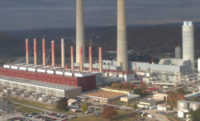 |
| TIME FOR CHANGE Old bundle (above) prepares to exit as new one moves in.(below). Steel bracing temporarily strengthens condenser wall. (Photos courtesy of Nooter Construction Co.) |
The Callaway plant, a single-unit, 1,126-MW pressurized-water reactor generating station, was completed near Fulton, Mo., in 1984. AmerenUE, St. Louis, plans to replace its four steam generators during the refueling outage scheduled for fall 2005 with a unit fitted with Alloy 690 thermally treated tubes. That change requires replacement of the condenser tubes with stainless steel because the copper-nickel material of the old tubes could cause corrosion in the new tubes.
 |
In May 2003, AmerenUE awarded a contract to Nooter Construction Co., St. Louis, to perform the condenser-tube replacement with tube bundles shop-fabricated by Thermal Engineering Inc., Pittsburgh, Kan. Under a separate contract, Thermal was responsible for design, fabrication and delivery of the bundles to the plant. Utility officials would not disclose project costs.
Twelve bundles arrived at the site from October 2003 until January, says Shannon Abel, AmerenUE project manager. In February, crews began strengthening the ground to carry the supermodules weighing up to 500 tons, erected a system of roller tracks to carry the modules up to the security fence, took down the turbine building wall and tied the units together with pipe bracing into supermodules up to 56 ft long, 30 ft high and 35 ft wide on jig stands outside the fence.
The start of plant shutdown on April 12 set an intricate ballet in motion. Workers welded W6 I-beams and other steel stiffeners onto the plate-steel condenser-building walls for temporary support, then cut away the structural supports from the old tube bundles.
|
In three days beginning May 4, the 18 old bundle modules were moved out and the 12 new ones in on 12-axle-line, double-wide Goldhofer self-propelled mobile transporters across a temporary bridge spanning the isolation security zone around the condenser. "It was a big concession" by the security department to breach the security-zone fence, says Abel. "You just dont mess with the security system, particularly after 9/11."
The shutdown was completed May 28 and plant operations resumed after 44 days, 10 more than the 34 days originally estimated. Nooters project manager, Randy Mason, says he had limited information on which to base a schedule estimate. "I had some limited printspenetration printson the inside of the condenser," but nothing on the condensers structure.
One cause of delay was the unexpectedly difficult working conditions. "The work inside the condenser box itself was harder than planned," says Abel. Conditions were cramped, temperatures were high and the temporary wall-support installation took longer than planned. He says productivity of the 400-person labor force was good, but admits it was hurt by the 12-hour-long shifts. "It extended the time required," he says.
reparing to replace a nuclear plants steam generators next year, a Missouri utility changed out the condenser tubing in an intricate operation complicated by post-9/11 security requirements. The operation was completed during a recent 44-day plant shutdown timed to coincide with a refueling outage, but it took nearly a third longer than planned.


Post a comment to this article
Report Abusive Comment